#semidesert
Explore tagged Tumblr posts
Text

#IFTTT#Flickr#davidgareja#georgia#monastery#semidesert#remote#orthodoxmonks#sandstonecliffs#cavemonastery#spiritualretreat#religioussite#sacredplace#ancientfrescoes#medievalarchitecture#solitude#silence#pilgrimage#hiddengem#culturalheritage#georgianhistory#mountainview#desertlandscape#borderregion#peaceful#contemplation#monasticlife#carvedrock#remotetravel#historicalsite
4 notes
·
View notes
Text

13 notes
·
View notes
Text
omg i hate my city. what do you mean we're in a heat wave???? it's may!!! it's the middle of the night and i'm sweating, it's humid, my head hurts, i'm dehydrated, and there are lizards in the porch coming out to enjoy the heat (not the cute kind)
#like i get it#it's a semidesert zone#BUT THIS DOESN'T FEEL SEMI AT ALL#I'M BURNING UP LIKE A WITCH IN A STAKE#I'M TOO WHITE FOR THIS MY SKIN IS LITERALLY FLAKING
12 notes
·
View notes
Text
The Early Temperocene: 135 million years post-establishment
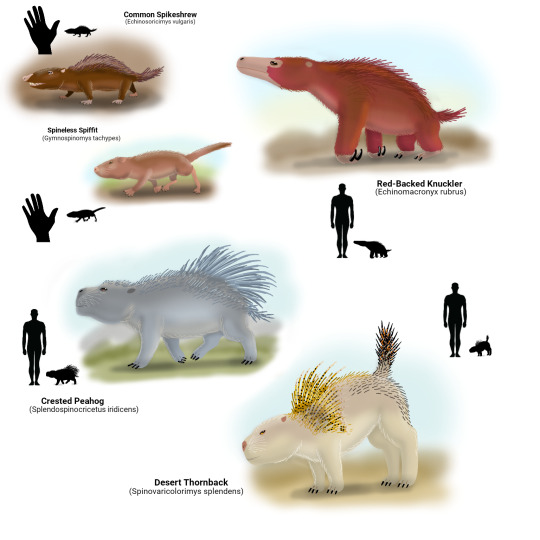
Sudden Spike: Heckhogs of the Early Temperocene
The long, harsh winter of the Glaciocene had whittled down the heckhogs to a small few species, ones that were not too dependent on tropical environments. The two genera that would make it through, the itchrats and the bluehogs, would mostly stagnate throughout the Glaciocene: but would find new diversity in the Temperocene as climates improved and new niches opened for the taking. In the meantime, numerous other clades have experimented on defensive quills, such as furbils, walkabies and porcuswines, to name a few. But the heckhogs endure, finding strange and creative new uses for their quills as the clade makes a strange new comeback.
Of the itchrats, one of the most widespread is the common spikeshrew (Echinosoricimys vulgaris), remaining quite similar to the basal itchrats though one more specialized for burrowing and hunting underground insects, a strategy that allowed its kin to survive the Glaciocene during cold spells that left little available forage aboveground. Some, even more adapted for tunneling, have abandoned their distinguishing quills altogether and came to rely more on speed and agility to escape predators. Spineless spiffits (Gymnospinomys tachypes) are one such species, with small eyes but sensitive whiskers and noses that allow it to navigate a complex maze of tunnels with ease.
But while most itchrats have remained quite small and conservative, one unusual species has emerged from this branch of the family tree: the red-backed knuckler (Echinomacronyx rubrus). A fairly large five to six kilograms in weight, knucklers are long-snouted foraging omnivores that use their large hooked claws for tearing into bark, digging up termite mounds, and excavating into the ground to access a wide variety of food such as insects, tubers, roots, tree sap and seeds. Active mostly at Beta-twilight, to which they owe their coppery-red coloration, they rest their weight upon the knuckles of their forelimbs, to avoid blunting their oversized claws that they use to search out their food. Sociable creatures, they live in small, matriarchal groups, consisting of one dominant female, her young, and several related females that take part in communally rearing the litter of up to ten pups. As breeding season approaches in the spring, they are often joined by small bands of wandering males that trail the dominant female wherever she may go, constantly emitting rapid chirping clicks to signal their readiness to mate.
Perhaps more remarkable, however, are the descendants of the other extant heckhog clade: the bluehogs. Now rather a misnomer, as many species now come in a wide array of colors aside from the iridescent blue, these remarkable family has evolved gaudy and elaborate displays with their quills, as, with many other species on the planet, they have evolved full trichromat color vision thanks to the presence of a red secondary sun and Beta-twilight making mutations enabling vision into the red spectrum more advantageous.
Male crested peahogs (Splendospinocricetus iridecens) retain the metallic-blue refraction of their translucent display quills, growing long, prominent crests of quills on their rears that they can rattle as a courtship display. Competing males often have rattling contests trying to make as loud as a racket as they can to intimidate potential rivals, while raising and lowering their spiny crests when trying to court prospective mates. Like its ancestor, the male peahogs shed these quills once the courting period is over, at about the time that the lucky ones accepted by a fertile female eventually pair up and dig a burrow together to raise their young.
More divergent from the ancestral formula, however, are the desert thornbacks (Spinovaricolorimys splendens), which live in arid, tropical semideserts and open savannahs. These have yellow-black striped quills concentrated mostly around the shoulder and tail area, and are used for display, as well as camouflage when hiding amongst dessicated, dry grasses and plants during the long, dry summers. Unlike the peahogs, the quills are sported by both sexes, though more colorful in the males, here colored not by refraction but by dietary pigments accumulated in the hair: an honest indicator of a healthy, well-fed male fit enough to remain in top shape even in times and in places when, and where, food is relatively scarce.
------------
53 notes
·
View notes
Text
December 6th, 2023


Saharan Sandlouse (Hemilepistus reaumurii)
Distribution: Found in the deserts of northern Africa and the Middle East, from eastern Algeria to western Syria. Most common in the Saharan and Negev deserts.
Habitat: Lives in dry habitats; deserts, semideserts, steppes, and occasionally on the edge of salt lakes.
Diet: Usually herbivorous, feeding on the leaves of desert plants. Can also consume dead organic matter and microbes found in the sand.
Description: The Saharan sandlouse is unique in the fact that it has managed to colonize an extremely hostile environment for most crustaceans: the desert. Small herbivores are fairly rare in these dry climates, and so these sandlouses make up an extremely important part of the food chain in desert ecosystems.
A few different adaptations allow the Saharan sandlouse to thrive in its environment. In order to stay hydrated, they will absorb water vapour from the air or from damp sand and, to mitigate water losses, they have an absorbent rectal epithelium which absorbs moisture that could be otherwise excreted with their feces. This species has also developed parental care, and is the only one in its genus to have done so. Parents are monogamous, and construct deep vertical burrows in the sand. Both sexes are involved in caring for offspring, bringing their brood food and protecting their burrow. Saharan sandlouse usually produce only one brood in their short lifetime.
(Images by Leonid A. Neymark and Ferenc Vilisics)
150 notes
·
View notes
Note
In diameter, the Earth is 7926 miles (12,760 kilometers). The temperature range is 14-16°C, but it can be as high as 56.7°C and as low as -89.3°C.
There are five oceans; The Pacific, Atlantic, Indian, Southern, and Arctic. Combined, they cover about 71% of the Earth.
The surface area of all land is about 148 million square kilometers (57 million square miles)
The biomes are Arctic, Tundra, Boreal Forest, Temperate Deciduous Forest, Temperate Grasslands, Dry Woodlands, Dry Shrublands, Desert, Tropical Rainforest, Tropical Deciduous Forest, Tropical Scrubland, Tropical Savanna, Semidesert/Arid Grassland, Polar Ice, and Mountains


The Cataloger: Nice! Then that's all my questions.
The Cataloger snaps zir fingers and zir glasses disappear, revealing zir eyes again.
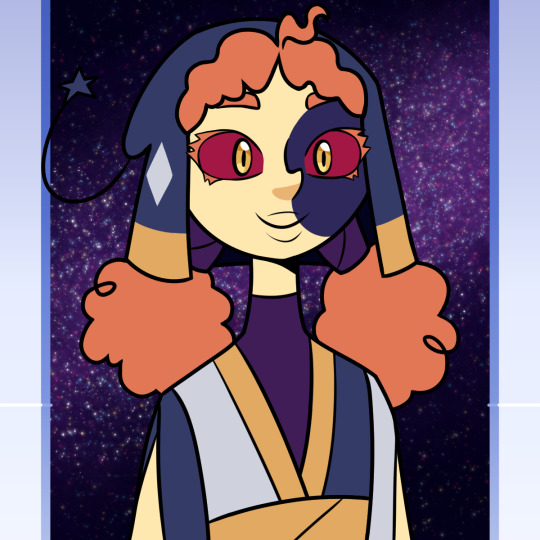
The Cataloger: Now I can just relax.

The Curator: Oh hey, that's what your eyes look like. That's so cool, they look like blood.

The Cataloger: Hee hee, yeah, I'm so cool. So cool that it needs to be contained.
#toh#the owl house#ask blog#ask the archivists#asks are open#id in alt text#toh oc#toh the archivists#the archivists#meteor shower event
15 notes
·
View notes
Text
"Negli stati del nord del Messico confinanti con gli Usa, la stampa locale riporta che stanno assistendo a un generalizzato CROLLO VERTICALE di migranti giunti lì per attraversare la frontiera. Le strutture di assistenza che fino a poco tempo fa erano stipate, ora risultano semideserte".
Gli enti Usa registrano di fatto un calo del 90% nei tentativi di passaggio rilevati. In più le DEPORTATION (lett. espulsioni) procedono a pieno ritmo.
Toh ma allora era tutto molto gestito spintaneo, non si trattava affatto di "innarrestabbili fenommeni epochali" come narra ancora adesso il mainstream & culturame sinistrato. E' DECISAMENTE IL CLIMA CHE CAMBIA.

23 notes
·
View notes
Text
Birdtober 12th and 13th, 2024 "Nest" and "Grasslands/Prairie"
Little sketches here, I was just trying to catch up...
For "Nest" we have Puerto Rican Parrots because my little brother wanted me to draw some
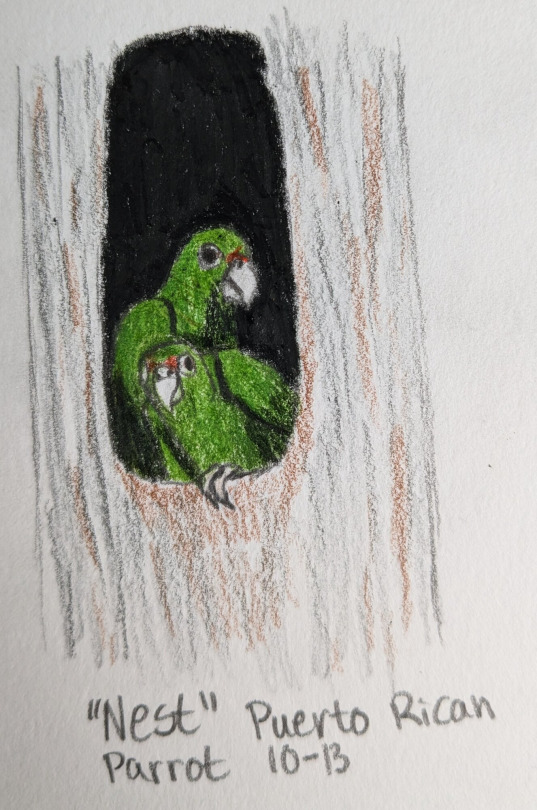
For "Grasslands/Prairie" a Painted Sandgrouse. I think they might live more in semidesert rather than grasslands but I don't care. I just wanted to draw this exquisite beauty. He's so gorgeous. I like how he looks half grouse, half pigeon.
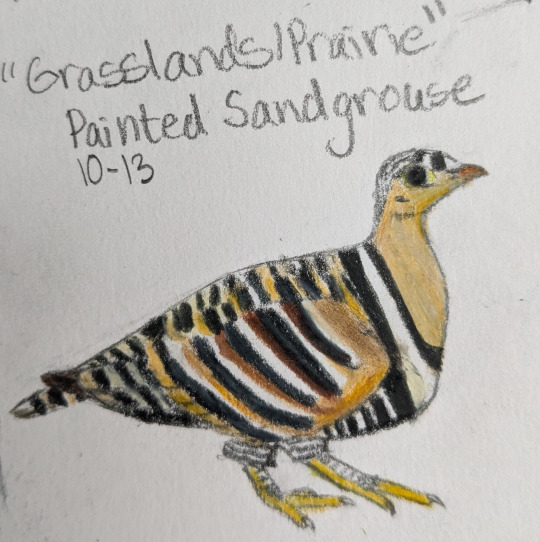
As you can see, these conclude the second page
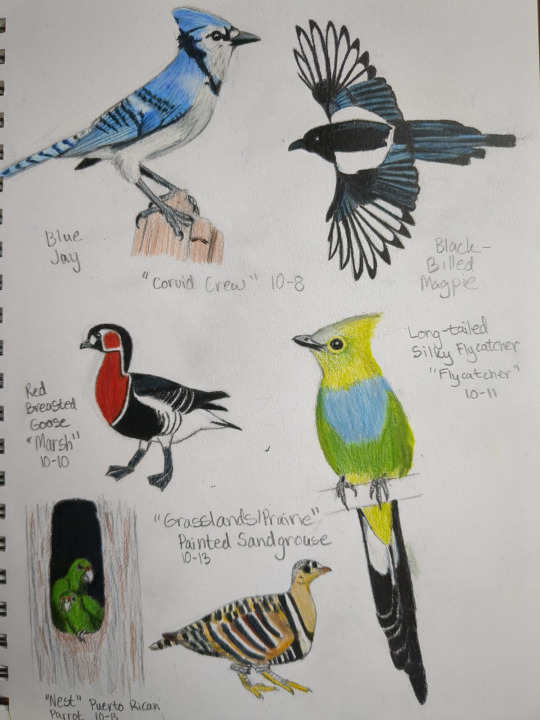
#ent tag#birdtober2024#bird art#painted sandgrouse#puerto rican parrot#puerto rican amazon#birdtober#2024#birdtoberclub2024#birdsofafeather
6 notes
·
View notes
Text

Nessun cenone,nessun pranzo,nessun scambio di regali come da tradizione. La mia vigilia e il mio Natale li ho passati portando il mio " saper fare" per il bene di una bambina,avanti e indietro su strade semideserte mentre tutto attorno c'era il caos .
Uno dei Natali più belli della mia vita..
40 notes
·
View notes
Text
Si avviarono insieme per le strade semideserte di Pavia, scambiandosi un sorriso e un colpetto con la spalla ogni tre passi come a controllare che l’altro fosse sempre lì. Ed erano sempre loro due, constatò Mauro felice, a parlare sempre delle solite cose, a discutere su cosa avessero sbagliato (per Mauro, non avevano sbagliato proprio un cazzo), esattamente come avevano fatto la sera prima al telefono, e innumerevoli sere prima ancora.
#mi sto divertendo non poco#sto trascurando il lavoro ma dettagli#hanno ucciso l'uomo ragno#fanfiction#fanfic#my fic#my story#di nuovo: tutto basato sulla serie tv e basta
2 notes
·
View notes
Text




Angulate Tortoise - seen near Paarl. A tough generalist that can survive in semidesert, fynbos, or thickets. Capable of thriving on grass, flowers, and succulents, these can live up to 32 years in the wild.
#south africa#africa#original photography on tumblr#wildlife photography#tortoise#reptiles#herpetology
3 notes
·
View notes
Note
tal pls i need more sarie content to distract me from the urge to abandon my wips and write about SAS:RH
HI i was going to write a whole drabble taking place during the show but then life stuff happened so take some sarie childhood lore
- she grew up on a sheep farm in Fraserburg, a tiny town smack in the middle of the driest part of the Karoo semidesert
- both of her parents are jewish, but they’re afrikaans-speakers; aka boerejode
- she has two older sisters, lenie (b. 1916) and hanna (b. 1918)
- she’s a twin!!!!! her twin brother is named louis and they’re super close
- she partook in Gender Shenanigans from a very young age - she and louis would swap clothes, and necessity meant they did the same chores on the farm (i could talk more about this vis a vis afrikaans gender roles but that’s a whole post in itself)
- shes a born and bred Karoo meisie; she knows how to shoot guns, herd sheep, ride horses, and navigate the desert (mike is her bff)
4 notes
·
View notes
Text
Not to be a pain in the ass, but I thought you guys might like to know the difference between a seal and a sea lion.
This picture describes it best:

The pinniped in the video is a sea lion. Elongated front flippers, external ear flaps, and rear flippers used to "walk" on land. It's actually cute.
(Fun fact, sea lions are closer related to bears than lions.)
And that particular lizard is an Argentine black and white tegu, the biggest of the "tegu" lizards. It is an omnivorous species, which inhabits the tropical rainforests, savannas, and semideserts of eastern and central South America. It is native to south and southeastern Brazil, Uruguay, eastern Paraguay, Bolivia, and Argentina.
They are sometimes kept as pets, being notable for their unusually high intelligence and their ability to be housebroken.
While some tegus can be friendly and enjoy human interaction, it is important to be aware of the potential for aggression and the risks associated with handling them, especially as they mature.
Tegus can have a lifespan of 15-20 years in captivity, with some being documented to live past 30.
Today's Seal Is: Making Contact With An Unknown Beast
#there are many benefits to being an animal lover#fauna#mammal#animals#sea lion#argentine tegu#pinniped#reptile#lizard
68K notes
·
View notes
Text
The Early Temperocene: 135 million years post-establishment
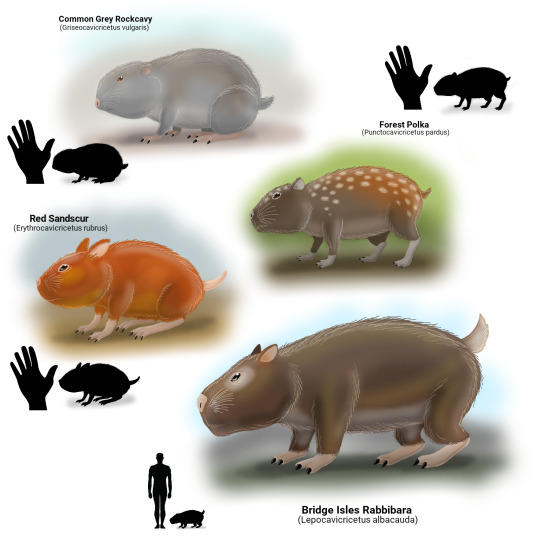
Guinea Mimics: The Gwinnies
The Cavioidecricetidae, also known as the gwinnies, are a group of duskmice belonging to the same clade as the hammibals and the pondrats, though of closer relation to the pondrats than the hammibals: having diverged sometime in the Middle to Late Rodentocene. The gwinnies are primarily small herbivores, in essence having taken over the niches occupied by the basal gouties and the broadheads during the Early Rodentocene, and adapted to feed on a wide array of foliage, such as roots, leaves, stems and flowers of the various grasses and cloverferns that grow across the world. They process these plant material with the help of hindgut fermentation, allowing them to extract nutrition from even the hardest-to-digest vegetation: however, a consequence of this is that they are required to ingest their droppings a second time in order to absorb their full nutritive content. Mother gwinnies thus produce these special pellets in greater amounts in the few weeks after weaning, as these processed, nutritious pellets are usually her offsprings' introduction to consuming solid food.
Throughout their long history, the gwinnies have not become as diverse as most other duskmice clades, but have persisted nearly across the globe in various niches of "small herbivorous rodent" in many different biomes. Breeding all year round, and producing relatively well-developed young per litter that are born fully-furred and open their eyes in a week or two, they, like most other duskmice, are rather low in most food chains and fear many predators, and thus defend themselves by digging burrows, hiding in crevices, and generally reproducing in large numbers to ensure the survival of a few.
One of the most abundant species in the Temperocene is the common grey rockcavy (Griseocavicricetus vulgaris) which is found throughout temperate regions, primarily in mountainous areas with plentiful small gaps among cliffs and ledges for it to seek shelter in. A nocturnal species with small eyes, it prefers to emerge under cover of dark, finding food with the aid of its powerful sense of smell and sensitive whiskers, and gorging itself all evening before retreating to its den by morning, with a stash of additional food it carries in its cheek pouches in order to feed on while seeking shelter during the day when predators abound.
In tropical forests, meanwhile, one may find a similar yet quite different relative: the forest polka (Punctocavicricetus pardus). This species, in contrast, is active during the day, and scampers about the forest floors of tropical jungle on its relatively-long legs, foraging for the low-growing shrubs and cloverferns found in the ground level and the understory. Here, there is abundant cover among the plants, tree roots and fallen logs, and its primary camouflage comes in the form of pale blotches on its body that mimic the speckled, dappled light on the forest floor, breaking up its outline and making it more difficult to see when it freezes in place to hide from threats. In addition to leaves and stems, the polka also relishes fallen fruit dropped from the canopy: making it an important seed-disperser that scatters tree seeds far and wide in places that are favorable for them to sprout.
In open deserts and arid semidesert, in the meantime, during the times when Beta alone in the sky casts the landscape in a brilliant red, the red sandscur (Erythrocavicricetus rubrus) emerges from its den to search for food. Like many animals in the desert, it avoids the searing rays of Alpha by emerging at a period of time when its dimmer, cooler twin instead reigns the sky. As the presence of a red secondary sun has favored the evolution of trichromat vision in many lineages, including predators, so too have prey evolved to hide under these conditions, with red-colored fur originating from erythrism: an unusual increase of red pigment in an animal's pelage that with Beta-twilight as a regular phenomenon became an unexpected survival advantage and thus became the normal state of many species. Well-concealed in the crimson light, the red sandscur is hardly conspicuous as it searches out desert succulents both as a source of food and water.
Most gwinnies of the Temperocene are quite conservative in build, having changed little from their early ancestors, but one significant exception dwells on a small chain of islands between the continents of South Ecatoria and Arcuterra: the Bridge Isles rabbibara (Lepocavicricetus albacauda). The largest of the gwinnies, at roughly twelve kilograms, it grew to such large sizes due to the isolation of its habitat from the mainland, and in the absence of competition grew to an enormous size, comparatively speaking. With its only threats being aerial ones from opportunistic predatory ratbats, it simply grew too large to be carried away by them, and while young may be occasionally vulnerable, adults face little threat and are generally unfazed as they graze on the abundant grasses in the Bridge Isles. The rabbibara, while continuing to survive well into the Middle Temperocene, would find its range restricted to the two northmost islands as its populations disappeared in the southernmost ones due to a period of unstable fluctuations in local food availability. Its absence in those areas, however, would favor a far stranger creature to take its place and become the dominant herbivore of the isles: the zeebeedee (Megalornithomys spp.), a grazing pterodent that, in the absence of predators, also grew to enormous proportions and abandoned its flight entirely.
--------------
44 notes
·
View notes
Text
Cerro El Jabalín
Cerro El Jabalín Photo: Sunset over semidesert in Coahuila Mexico by Antonio Olvera This majestic mountain, whose name translates to “The Wild Boar Hill,” is a treasure trove of biodiversity and breathtaking landscapes. Fast Facts Country: Mexico State/Province: Coahuila Mountain Range: Sierra Madre Parents: Sierra Madre Elevation: 11,286 feet / 3,440 meters Prominence: 4,396 feet /…
0 notes
Text
La vendetta è solo per il maschio alpha
Avrete visto… quanti? Mille film in cui il ragazzo assiste alla morte del padre e della madre e quando cresce corre tra radure semideserte e paesaggi mistici per trovare l’assassino e attuare il suo piano di vendetta. Altrettanti sono i film, ma anche e soprattutto le trame dei libri, in cui il personaggio principale è affranto dalla perdita di moglie e figli, o moglie incinta, figlia, tutte…

View On WordPress
#Autodifesa#Controllo#Corpi#Cultura Patriarcale#Legittima Difesa#Moralismo#Sessismo#Stereotipi#Vendetta#Violenza di Genere#Violenza Istituzionale
0 notes